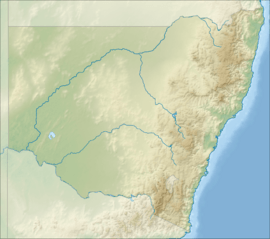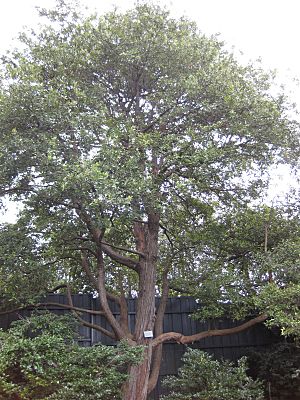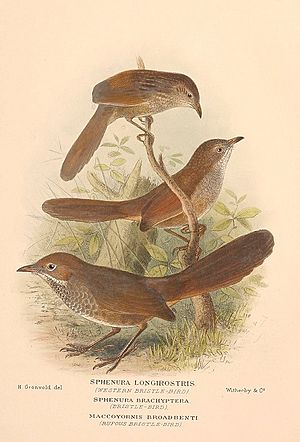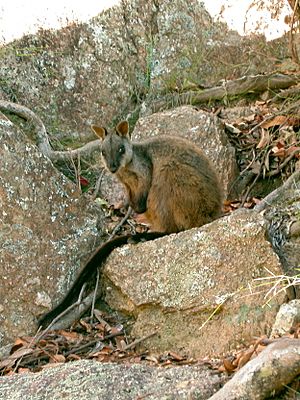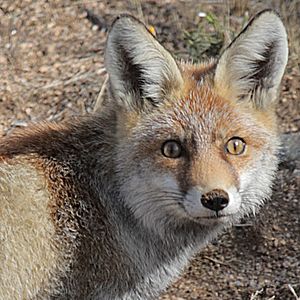Kangaroo River Nature Reserve facts for kids
Quick facts for kids Kangaroo River Nature ReserveNew South Wales |
|
|---|---|
|
IUCN Category Ia (Strict Nature Reserve)
|
|
| Nearest town or city | Kangaroo Valley |
| Established | January 2001 |
| Area | 1.26 km2 (0.5 sq mi) |
| Managing authorities | NSW National Parks and Wildlife Service |
| Website | Kangaroo River Nature Reserve |
| See also | Protected areas of New South Wales |
The Kangaroo River Nature Reserve is a special protected area in New South Wales, Australia. It is part of the Kangaroo Valley Group of Nature Reserves. This reserve is located in the beautiful Kangaroo Valley, which is found in the Southern Highlands and South Coast regions.
The reserve is about 150 kilometres (93 mi) south of Sydney. It's also about 50 kilometres (31 mi) southwest of Wollongong and 16 kilometres (9.9 mi) northwest of Nowra. The main goal of this reserve is to protect the amazing plants and animals that live here. Other important protected areas nearby include Morton National Park and Budderoo National Park.
Contents
Why Protect This Area?
Nature reserves like Kangaroo River are very important. They help protect plants and animals from things that could harm them. This includes making sure vulnerable species don't disappear. Even common species can be at risk if their environment changes too much.
The National Trust has also marked parts of Kangaroo Valley and its nature reserves as "Scenic Protection Areas." These areas are known for their beautiful rainforests, deep gullies, waterfalls, and cliffs.
Amazing Ecosystems
The Kangaroo River Nature Reserve is a special place where different types of habitats meet. You can find areas similar to the coast to the east and the tablelands to the west. Small areas with different plants, creeks, and rocks create unique "microhabitats."
These protected areas offer a safe home for many different plants and animals. Even though some reserves are not huge, they are vital for keeping animal and plant populations healthy. Sometimes, these smaller reserves are the only way to protect species facing big threats.
Plant Life
Kangaroo Valley has several types of forests, including wet sclerophyll forests, heathlands, and rainforests. The rainforests usually grow in the valley's gullies and near creeks. Here, you can find many cabbage tree palms (Livistona australis). You might also see interesting plants like birds-nest ferns (Asplenium nidus) and tree ferns (Cyatheales).
A rare plant called the leafless tongue orchid (Cryptostylis hunteriana) has been seen between Batemans Bay and Nowra. Another special plant, the Illawarra stinking arum (Typhonium eliosurum), grows near the Kangaroo River reserve. This plant is listed as a Rare or Threatened Australian Plant (RoTAP).
Most of the forests in the Kangaroo Valley reserves are old and mature. However, the Kangaroo River Nature Reserve has some areas that were disturbed in the past. This was due to logging, fires, and gravel mining. You can still see new plants growing back in these spots.
Flora of the Reserves
The four main reserves in this group have five types of plant life: heathland, open forest, rainforest, and tall moist forest. The types of plants growing in an area depend a lot on the soil. Some plants like rich, volcanic soil, while others can grow in shallow soils like sandstone or mudstone, even with less water.
In the Kangaroo River Nature Reserve, you can find trees like scribbly gum (Eucalyptus sclerophylls), red bloodwood (Corymbia polycarpa), and grey gum (Eucalyptus punctata). This reserve was once used for grazing animals. A part of it was also used to dig up gravel for building roads like those to Bendeela Dam and Tallowa Dam.
The Rodway Nature Reserve has similar plants, but also some unique ones. These include Sydney peppermint (Eucalyptus piperita), silvertop ash (Eucalyptus sieberi), turpentine (Syncarpia glomulifera), and brown barrel (Eucalyptus fastigata). You might also see white topped box (Eucalyptus quadranulata), river peppermint (Eucalyptus elata), flax leaf paperbark (Melaleuca linariifolia), yellow tea tree (Leptospermum polygalifolium), and currant bush (Leptomeria acida).
The Cambewarra Range Nature Reserve is the largest, covering 1684 hectares. Most of its trees are old-growth forest. Some special trees found here are coachwood (Ceratopetalum apetalum), sassafras (Doryphora sassafras), Lilly pilly (Syzgium smithii), and native laurel (Cryptocarya glaucescens).
An endangered shrub called Solanum celatum has been found in the Cambewarra Range reserve. The vulnerable furred tongued orchid (Cryptostylis hunteriana) also grows there, specifically at a spot called the Red Rock plateau.
The Barrengarry Nature Reserve is a smaller area of about 21 hectares (52 acres). It is home to trees like Sydney blue gum-bangalay (Eucalyptus saligna), turpentine (Syncarpia glomulifera), spotted gum (Corymbia maculate), and blackbutt (Eucalyptus pilularis).
Animal Life
Many amazing birds, amphibians, and mammals live in these reserves. Some of them are listed as threatened under the NSW Threatened Species Conservation Act 1995.
Birds
Birds you might find include the Eastern bristlebird (Dayornis brachypterus brachypterus), swift parrot (Lathamus discolour), powerful owl (Ninox strenua), sooty owl (Tyto tenebricosa), olive whistler (Pachycephala olivacea), regent honeyeater (Xanthomyza Phrygia), turquoise parrot (Neophema pulchella), and the Australian masked owl (Tyto novaehollandiae).
The eastern bristlebird lives on the ground in thick, fire-prone areas. Their numbers have dropped because of fires, losing their homes, and abandoning their nests. This means we need to be very careful with fire management in areas where these birds live. It's important to leave unburned plants for them to hide in.
Amphibians and Reptiles
Only one amphibian, the giant burrowing frog, is listed as threatened in this area. There are also two reptiles: the broad-headed snake and the heath monitor.
Mammals
Seven mammals on the threatened list live here. They are the brushed tailed rock-wallaby (Petrogale penicullata), yellow-bellied glider (Petaurus australis), spotted-tailed quoll (Dasyurus maculates), long-nosed potoroo (Potoous trudactylus), eastern bent-wing bat (Miniopterus schreidersii), smoky mouse (Pseudomys fumeus), and greater broad-nosed bat (Scoteanax rueppellii).
The yellow-bellied glider and eastern bristlebird are considered endangered in this region. For the yellow-bellied glider to survive, it's crucial to protect the sap trees they use. Other trees like the grey gum (Eucalyptus punctata) are also important for them.
The brush-tailed rock-wallaby is another endangered species in this area. These wallabies live in small groups, usually up to 30 individuals. They prefer rocky areas that are naturally separated from each other.
Threats to the Environment
The biggest dangers to the plants and animals in Kangaroo Valley are new buildings, fires, and introduced species. The Kangaroo River Nature Reserve itself was once used for digging up gravel and for grazing animals.
In the Barrengarry, Rodway, and Cambewarra Range reserves, human activities started long ago. In the early 1800s, people began logging red cedar trees. After that, forests were cleared to make way for farms.
Today, problems continue with weeds and introduced animals like foxes, feral goats, and rabbits. When reserves are next to cleared areas, it creates "edge effects." This means weeds can spread easily, and farm animals or wild animals can wander into the protected areas.
Some ways people try to prevent bushfires can also cause harm. For example, burning large areas without care or building roads through rainforests can damage these sensitive environments.
Kangaroo Valley is a popular place for holidays. This also puts pressure on the natural areas. Tourist services like campsites and walking trails can sometimes affect the environment.
How the Reserves Are Managed
The National Parks and Wildlife Act 1974 No.80 is a law that helps create plans to manage these reserves. These plans make sure that remaining forests and endangered species are protected. The Kangaroo Valley group of nature reserves has one of these important management plans.
Local environmental groups, like the Kangaroo Valley Environment Group Incorporated, are very important. They help maintain and manage the reserves. They get support and money from government groups like the Sydney Catchment Authority and Shoalhaven City Council. Other local groups helping out include the Broger’s Creek Landcare group, the Upper Kangaroo Valley Landcare Group, the Friends of the brush-tailed rock wallaby, and the Kangaroo Valley Garden Group.


